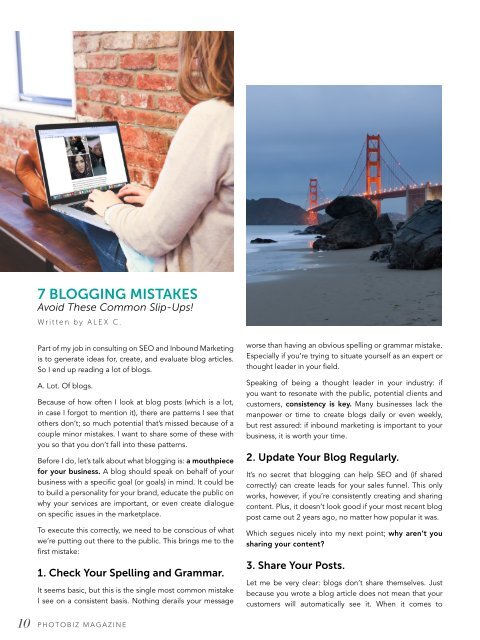PhotoBiz Magazine // Summer 2017
The PhotoBiz magazine is a key resource for photographers, teaching strategies about SEO, website design, marketing & more. Visit blog.photobiz.com for more.
The PhotoBiz magazine is a key resource for photographers, teaching strategies about SEO, website design, marketing & more. Visit blog.photobiz.com for more.
Create successful ePaper yourself
Turn your PDF publications into a flip-book with our unique Google optimized e-Paper software.
7 blogging mistakes<br />
7 BLOGGING MISTAKES<br />
Avoid These Common Slip-Ups!<br />
Written by ALEX C.<br />
Part of my job in consulting on SEO and Inbound Marketing<br />
is to generate ideas for, create, and evaluate blog articles.<br />
So I end up reading a lot of blogs.<br />
A. Lot. Of blogs.<br />
Because of how often I look at blog posts (which is a lot,<br />
in case I forgot to mention it), there are patterns I see that<br />
others don’t; so much potential that’s missed because of a<br />
couple minor mistakes. I want to share some of these with<br />
you so that you don’t fall into these patterns.<br />
Before I do, let’s talk about what blogging is: a mouthpiece<br />
for your business. A blog should speak on behalf of your<br />
business with a specific goal (or goals) in mind. It could be<br />
to build a personality for your brand, educate the public on<br />
why your services are important, or even create dialogue<br />
on specific issues in the marketplace.<br />
To execute this correctly, we need to be conscious of what<br />
we’re putting out there to the public. This brings me to the<br />
first mistake:<br />
1. Check Your Spelling and Grammar.<br />
It seems basic, but this is the single most common mistake<br />
I see on a consistent basis. Nothing derails your message<br />
worse than having an obvious spelling or grammar mistake.<br />
Especially if you’re trying to situate yourself as an expert or<br />
thought leader in your field.<br />
Speaking of being a thought leader in your industry: if<br />
you want to resonate with the public, potential clients and<br />
customers, consistency is key. Many businesses lack the<br />
manpower or time to create blogs daily or even weekly,<br />
but rest assured: if inbound marketing is important to your<br />
business, it is worth your time.<br />
2. Update Your Blog Regularly.<br />
It’s no secret that blogging can help SEO and (if shared<br />
correctly) can create leads for your sales funnel. This only<br />
works, however, if you’re consistently creating and sharing<br />
content. Plus, it doesn’t look good if your most recent blog<br />
post came out 2 years ago, no matter how popular it was.<br />
Which segues nicely into my next point; why aren’t you<br />
sharing your content?<br />
3. Share Your Posts.<br />
Let me be very clear: blogs don’t share themselves. Just<br />
because you wrote a blog article does not mean that your<br />
customers will automatically see it. When it comes to<br />
content, you are your biggest cheerleader. Share that<br />
information to social media, to your email list—heck, by<br />
word of mouth if you have to. The more you share, the<br />
more users you get to your site. The more users you get to<br />
your site, the more likely it is that you’ll land a lead.<br />
Also, let’s be honest here: even when you’ve shared the<br />
post, your job is not done. Users that read it may have<br />
questions. They may have feedback (not always positive).<br />
That’s why it’s incredibly important to…<br />
4. Interact with Your Audience.<br />
If someone takes the time to write a comment, like your<br />
post or share it, that means you piqued their curiosity. So<br />
much so that they decided to interact with your brand.<br />
Don’t take this for granted!<br />
Thanking someone for their kind words goes a long way<br />
and increases the probability that the same user will<br />
continue to read your content. Addressing a negative<br />
comment (especially if it’s based on misinformation) can<br />
improve your brand’s reputation by leaps and bounds.<br />
Adding to the conversation makes users feel like you’re<br />
involved. This is important, since a blog can be the<br />
“personality” of your business. It is called social media<br />
after all.<br />
The next issue I see far too often as well: You’ve spent all<br />
this time researching topical and timely content, writing,<br />
and sharing consistently at the right times; so why aren’t<br />
you driving users deeper into your site?<br />
5. Create Calls-to-Action to<br />
Achieve Your Goals.<br />
This isn’t just a quick sentence that says “check out more<br />
of my work/products”, this is an actual declaration of<br />
why there is value in checking out samples of your work/<br />
products, or in contacting you to learn more. This requires<br />
using verbiage that entices a user and makes them want<br />
to explore more of your site or other relevant articles. The<br />
goal of a blog for business is generally to inform, persuade,<br />
and establish interest in your products or services. You’re<br />
doing this more effectively if you’re sending blog users to<br />
the site that you’ve optimized for their visit.<br />
Oh, and by the way…<br />
6. Make Accessing Relevant Content as<br />
Convenient as Possible.<br />
A good call to action not only entices the user, it<br />
sends that user to relevant information quickly. Don’t<br />
10 PHOTOBIZ MAGAZINE







